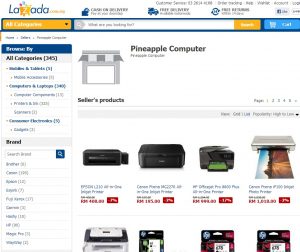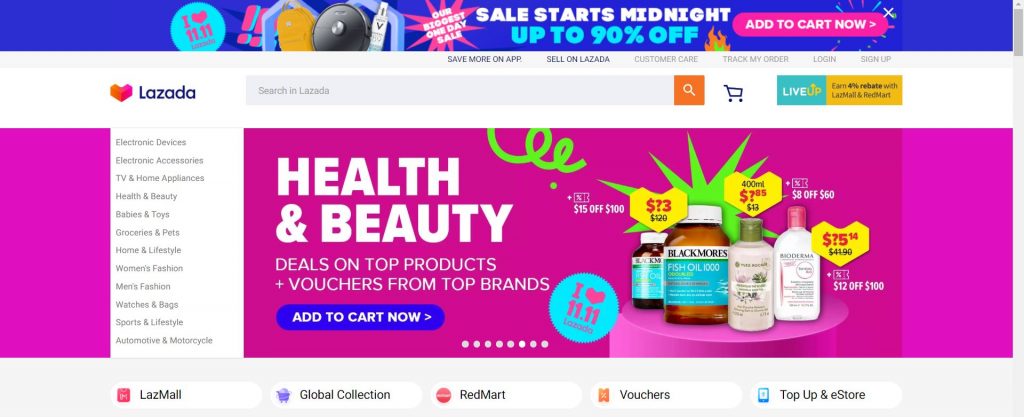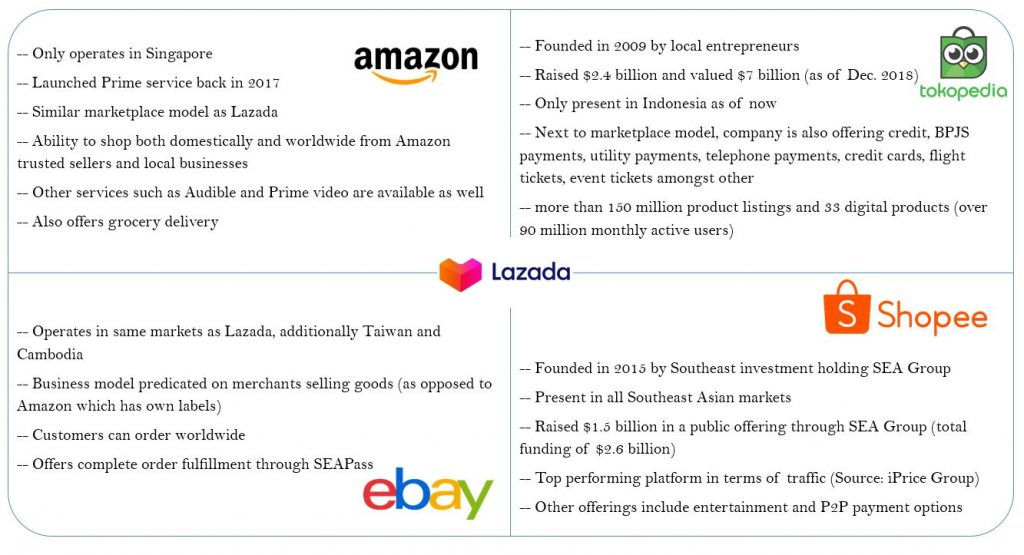The Lazada Business Model – How Does Lazada Work & Make Money?
Southeast Asia’s online economy hit $100 billion for the first time this year according to Google and Temasek. By 2025, it is projected to triple that.
One of its
major players is Singapore based Lazada. This article will cover how the
company operates, its founding history and the various ways it makes money.
Mục lục bài viết
How Lazada Works And Operates
Lazada is a
B2B2C marketplace model in which so-called merchants sell goods on their
platform. The company offers products in some of the following categories:
- Electronics
- Health
& Beauty - Groceries
& Pets - Home
& Living - Women’s
& Men’s Fashion - Automotive
& Motorcycle
In order to
provide a seamless transaction for their customers, Lazada makes sure to handle
the accompanying processes such as shipping, payment, or reclamations. Merchants
therefore only have to focus on providing the relevant goods to the most appropriate
customer demographic.
Consumers
can choose to shop either on Lazada’s desktop website or any of the mobile
applications. Additionally, their LazMall shop provides products, which have
been authenticated for their legitimacy (as consumers in Asia often suffer from
fake and/or poor products).
How Lazada Started: A Short History
If you
thought Lazada was created by a local group of online entrepreneurs who just
happen to have a knack for good branding, you’re wrong.
Lazada was founded in 2012 by German internet investment and venture building company Rocket Internet. Rocket is most notably known for its copycat business model. It thereby replicates (mostly US based) companies and starts similar firms in parts of the world where that very same business model does not exist yet.
Its operating model is characterized by picking high performers (from firms such as McKinsey or Goldman Sachs) and arming them with capital and expertise. One of their most famous investments is European e-commerce giant Zalando, a direct replica of US-based Zappos. However, back to Lazada!
The Lazada website launched in March of 2012. Its initial business model was to sell consumer goods such as clothing or electronics directly to potential customers (B2C). The company initially launched in Indonesia, Malaysia, the Philippines, Thailand and Vietnam.
In 2013, the company added the current marketplace model (B2B2C). This allowed third-party sellers to offer goods on their platform. By 2014, that part of the business accounted for over 70 percent of all spending on the platform. Additionally, Lazada launched in Singapore during the same year.

 Wayback Machine
Wayback Machine
During the
first years after its inception, Lazada’s focus lied primarily in accelerating
its growth. Unsurprisingly, the company lost
over $200 million in the first two years of operation alone. One of the key
challenges Lazada faced (and still does) is the fact that Asian consumers often
prefer
shopping in one of the big local malls.
While
growth remained impressive, losses piled up conversely. In addition, since
Rocket is a public company bound to profitability, its investments in Lazada
started to become unsustainable. Therefore, in early 2016, Alibaba decided to take
a controlling stake in Lazada. It invested $1 billion to acquire 51 percent
of the company.
In 2018,
Lucy Peng, one of Alibaba’s co-founders, replaced Maximilian Bittner as raining
CEO of the company. She stepped
down from that role in December 2018. Pierre Poignant, one of Lazada’s
co-founders, became her replacement.
Lazada has furthermore
invested in and acquired various companies, which it integrates into its core
platform. The most famous instance is the acquisition of Singapore based
grocery delivery startup RedMart, which
the company acquired in 2016.
How Does Lazada Make Money?
After
investing billions of dollars into the business, what is Lazada’s plan to
achieve a positive return on investment? Similar to its parent company Alibaba
as well as Amazon, Lazada found a multitude of money earning channels. Let’s
dive into them in more detail.
Lazada Marketplace
Similar to
Amazon and eBay, Lazada offers a marketplace model in which merchants sell various
consumer products on their platform. Lazada then takes care of the payment and
shipment process (if seller is Lazada authorized).
Merchants
are heavily support to ensure they increase conversion and thus total items
sold. Therefore, Lazada has launched multiple initiatives aiming at improving
their merchants business. Examples include Lazada University and
Super
eBusinesses.
Once a sale
is made, Lazada takes a commission between 1
to 4 percent, depending on the product category.

 lazada.sg
lazada.sg
LazMalls
LazMalls, in simple terms, is a more luxurious version of its core marketplace. As Lazada states, it “is a curated selection of leading international and local brands, top-rated online brands and authorized brand distributors.”
Furthermore,
customers are guaranteed a 15 day return period and next day delivery. If
merchants want to sell on this platform, they have to go through a screening
process and fulfill certain criteria.
Lazada
makes money by charging merchants a commission on every sale. It is capped at 5 percent.
Top Up & eStore
Through the
Top Up and eStore, customers can purchase top ups on their prepaid phones
(creative, right?) and other services such as Spotify or Xbox.
Other
offerings include, for instance, gift cards, insurance, or food and beverage
coupons.
Commissions
are not disclosed publicly, and most likely based on each individual agreement.
Grocery Delivery Through RedMart
As
previously stated, Lazada acquired grocery delivery startup RedMart back in
2016. As of today, the service is only available in Singapore.
Grocery delivery is often characterized by thin margins and high operational complexity. Hence, Singapore with its potent consumer base and advanced infrastructure is a logical market to enter. However, Lazada disclosed plans to launch in another city by the end of 2019.
Within its food delivery business model, Lazada and/or RedMart works together with existing grocers such as Adyen. It hereby takes a commission from the order basket as well as charging fixed fees for delivery.
LiveUp Program
Lazada’s LiveUp is an
exclusive membership program, which allows consumers to save money on various
services and at different partners. Examples include:
- 4
percent rebate on every LazMall order - Free
delivery on RedMart above 40 SGD - Two
free months of Netflix
Other
partners include the likes of Grab, Foodpanda, Agoda, or anywhr. Customers can
either pay on a monthly or yearly basis.
Fintech Solutions
As Lazada handles billions in Gross Merchandise Volume (GMV), a logical step is to invest in payment and financing solutions for both its customers and merchants.
Lazada achieves this by teaming up with other local players in the Fintech space. One example includes Lazada’s cooperation with Malaysian P2P lending platform Funding Societies. The deal allows Lazada merchants to access various credit options to fund their business.
Another example is the recent partnership with Singapore based AsiaKredit. The collaboration enables Lazada’s customers to buy products on fixed monthly installments (similar to the business model of Klarna).
Lazada’s Corporate Mission And Vision
During
their 7th year anniversary party, Poignant revealed what Lazada
values and envisions going forward. As he stated, their mission and vision
going forward is to “accelerate progress
in Southeast Asia through commerce and technology.”
He added: “We
are a SEA company and love the region and diversity which also brings a lot of
complexity. We want to transform retail, both online and offline. And in the
next few years, you will see more initiatives as we integrate with the offline
world.”
Lazada’s
goal is therefore not to be a simple platform for buying only, but offer
technology, logistics and payment solutions to accelerate the growth of local
businesses and consumers alike.
Additionally,
they want to move away from a simple “search, click and buy” model towards
creating a unique experience around the shopping process. Poignant referred to
this as “shoppertainment”.
Lazada’s Ownership, Funding, Valuation And Potential IPO
According
to Crunchbase,
Lazada has raised over $4.2 billion in 9 funding rounds. In April 2016, Alibaba
acquired a
51 percent stake in the company, becoming the company’s controlling
shareholder. During the acquisition, Lazada was valued at $1.5 billion.
A little
over a year later, in June of 2017, Alibaba raised
its stake in the company from 51 percent to 83 percent. This deal had the
company valued $3.15 billion and required an additional investment of $1.5
billion.
In March of
2018, Alibaba injected another $2 billion, but did not disclose any valuations.
In case you wonder: the 2017 and 2018 investments respectively have mostly been
secondary
market investments and therefore do not count against the overall money
invested ($4.2 billion).
Regarding a
potential IPO, no plans have been disclosed as of today. With Alibaba as a
strong and solvent backer, there is certainly no financial need to go public. That
is not case for its competitors, which we will cover in the next section.
Lazada’s Main Competitors
Since
Lazada is present in many consumer product categories, its competitors
potentially range from fashion commerce shops like Zalora to electronics resellers like Harvey Norman. In order to keep
things simple, only competitors with a marketplace model will be covered in
this analysis.
Lazada’s four main competitors are Amazon, eBay,
Tokopedia, and Shopee.

 Own Illustration
Own Illustration
Other
competitors in the space notably include Carousell
and Bukalapak. We the latter, Lazada is said to be in talks regarding
a potential merger. The joint company would instantly become Indonesia’s
market leader.
Does Lazada Ship And Operate Internationally?
Apart from
their home markets in Southeast Asia, Lazada recently started to enable merchants
to ship goods worldwide. The service is called Lazada
Global Shipping (LGS). Lazada hereby takes care of fulfillment, ranging
from packaging to transportation.
Key Takeaways
- Lazada
was founded by German tech venture builder Rocket Internet - Due
to a high cash burn, the company had to be sold to Alibaba for $4 billion - While
the build-up certainly has been costly, Lazada seems to be leading the pack in
the race for Southeast Asian commerce supremacy - It
started to implement a full shopping experience, both for merchants and
consumers - Through
the launch of more services and partnerships, Lazada will try to follow the
likes of grab and Go-Jek in becoming one of the region’s “super apps”











